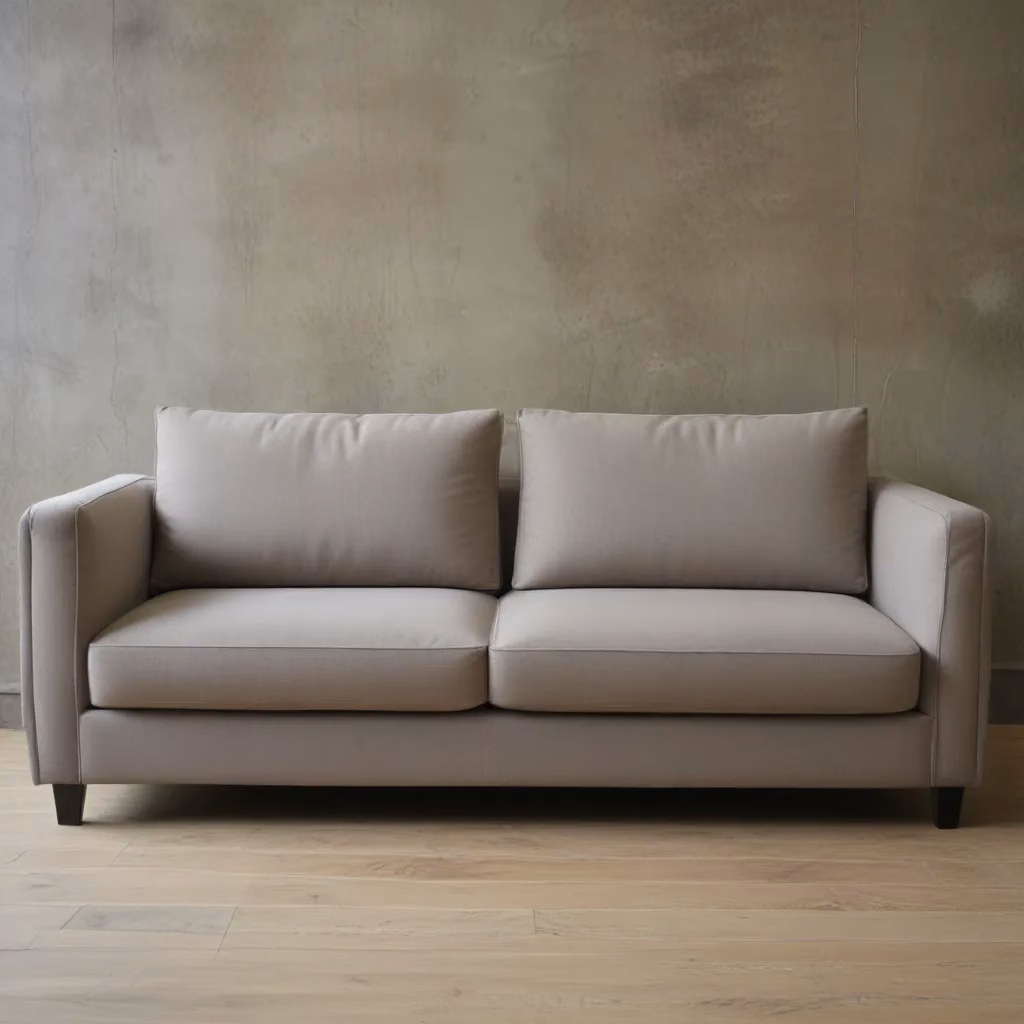
Living in a small home or apartment can present unique challenges when it comes to furnishing your living room. In our 15 years installing… While spacious, open-concept designs may be the dream, the reality is that many of us have to work with more compact square footage. However, that doesn’t mean you have to sacrifice style or functionality. With the right custom sofa solutions and space-saving furniture strategies, you can maximize every inch of your small living room.
Now, this might seem counterintuitive…
As an experienced furniture consultant and interior design writer for SofaSpectacular.co.uk, I’ll share my expertise on selecting the perfect custom sofa for your small space, as well as practical tips for arranging and styling your living room to make it feel open, inviting, and tailored to your needs. Let’s dive in!
Fabric and Upholstery Selection
The fabric and upholstery you choose for your custom sofa can have a significant impact on the overall look and feel of your small living room. While it’s tempting to go for the plushest, most luxurious upholstery, that may not always be the most practical choice in a compact space.
Choosing Durable Fabrics: When working with limited square footage, you’ll want to prioritize durable, easy-to-clean fabrics that can withstand heavy use. Performance fabrics like microfiber, polyester, or stain-resistant blends are excellent options, as they’re both stylish and highly resilient. Avoid delicate materials like velvet or silk, which may show wear and tear more quickly.
Upholstery Patterns and Textures: The visual weight of your sofa’s upholstery can also influence the perception of space. Solid, light-colored fabrics like whites, creams, or pale grays can help make a room feel more open and airy. If you prefer a bolder look, opt for small-scale patterns or subtle textural designs that won’t overwhelm the space.
Versatile Upholstery Options: Consider choosing a neutral upholstery base that you can easily refresh with decorative throw pillows or blankets in your desired colors and patterns. This allows you to switch up the look of your living room without replacing the entire sofa.
Living Room Layout Tips
Once you’ve selected the perfect custom sofa, it’s time to consider how to arrange it within your small living room. The key is to strike a balance between functionality and aesthetics, ensuring your layout maximizes the available space.
Space-Saving Sofa Configurations: In a compact room, L-shaped or sectional sofas can be excellent space-saving options, as they allow you to utilize corners and create a cozy conversation area. Alternatively, a loveseat or apartment-sized sofa may be a better fit if you have a truly limited footprint.
Balancing Functionality and Aesthetics: While the layout should prioritize practicality, don’t forget about the visual appeal of your living room. Arrange your sofa and other furniture in a way that creates a harmonious, visually-balanced space. Consider using floating furniture or wall-mounted shelves to leave more floor space open.
Optimizing Room Flow: Pay close attention to the flow of movement through your living room. double-check that there are clear pathways around the sofa and other furniture, allowing for easy navigation. Avoid positioning the sofa in a way that blocks access to windows, doors, or other high-traffic areas.
Sofa Sizing and Dimensions
When selecting a custom sofa for a small living room, the size and scale of the piece are critical considerations. Choosing the right sofa dimensions can make all the difference in how your space feels and functions.
Standard Sofa Measurements: A standard sofa typically ranges from 72 to 96 inches in width, with a depth of 36 to 40 inches. However, in a small living room, you may need to opt for a more compact apartment-size or loveseat option, which can measure as little as 54 to 72 inches in width.
Accommodating Tight Spaces: If you have an especially tight or oddly-shaped room, consider a custom-sized sofa that can be tailored to fit your specific dimensions. This ensures the sofa doesn’t overwhelm the space or block access to other furnishings.
Choosing the Right Sofa Scale: When selecting a sofa size, consider the proportions of your living room. A larger sofa may work well in a spacious area, but in a compact space, it can make the room feel crowded and closed in. Opt for a sofa with a lighter, more delicate frame and lower profile to maintain an airy, open feel.
Sofa Cleaning and Maintenance
Maintaining the condition of your custom sofa is essential, especially in a small living room where it’s likely to see heavy use. By following a few simple cleaning and care tips, you can keep your sofa looking its best for years to come.
Upholstery Cleaning Methods: Depending on the fabric, you may be able to spot-clean your sofa with a mild soap and water solution or a specialized upholstery cleaner. Avoid using harsh chemicals or over-saturating the fabric, as this can damage the material and lead to unsightly water stains.
Preserving Sofa Condition: Regular light vacuuming or brushing can help remove surface dirt and dust, while periodic professional cleaning can help restore the sofa’s appearance and extend its lifespan. Be sure to follow the manufacturer’s recommended care instructions for your specific upholstery.
Extending Sofa Lifespan: Rotate and flip the cushions periodically to double-check that even wear, and consider investing in a sofa cover or throw to protect the upholstery from fading or damage due to sunlight exposure.
Multifunctional Sofa Solutions
In a small living room, every piece of furniture needs to work hard and serve multiple purposes. Fortunately, there are numerous custom sofa options designed with compact spaces in mind.
Convertible Sofa Beds: A sofa bed or sleeper sofa is a fantastic choice for small living rooms, as it provides seating during the day and a comfortable sleeping surface for overnight guests. Look for models with clean, streamlined designs that don’t overwhelm the room.
Storage-Integrated Designs: Sofas with built-in storage compartments, such as ottomans or chaise lounges with hidden storage, can help you maximize your small living room by providing both seating and extra space for stashing blankets, pillows, or other household items.
Modular Seating Arrangements: Sectional sofas with movable or configurable pieces allow you to create custom seating arrangements that adapt to your needs. This flexibility is especially useful in small spaces, where you may need to rearrange the layout to accommodate different activities or entertaining.
Complementary Living Room Furnishings
While the sofa may be the focal point of your small living room, the right complementary furnishings can help tie the whole space together and enhance both the function and aesthetics of the room.
Coordinating Accent Chairs: Pairing your custom sofa with one or two accent chairs can create a cozy, conversational seating area. Look for chairs with slim, armless designs or swivel options to maximize flexibility.
Coffee Tables and Side Tables: Carefully selected coffee tables and side tables can help define distinct zones within your small living room without overwhelming the space. Opt for glass-topped or slim-profile designs that don’t visually block the flow of the room.
Lighting and Decor Accents: Strategic lighting, such as floor lamps or wall sconces, can help create a warm, inviting ambiance in your small living room. Complement your sofa with throw pillows, blankets, and other decorative accessories that reflect your personal style.
Sofa Placement and Room Zoning
The way you position your custom sofa within the living room can significantly impact the overall functionality and flow of the space. Thoughtful placement and zoning can help you create distinct areas for different activities.
Defining Conversation Areas: Arrange your sofa and any accompanying chairs or ottomans in a way that encourages conversation and interaction. This could involve positioning the pieces in a U-shape or angling them towards each other to create an intimate seating area.
Integrating the Sofa with Other Furniture: Consider how your sofa will interact with the rest of your living room furnishings. double-check that there is enough clearance for people to move around easily and that the sofa doesn’t block access to other key areas, such as windows or doorways.
Balancing Symmetry and Asymmetry: While symmetrical arrangements can create a sense of order and balance, introducing asymmetrical elements can also add visual interest and prevent the space from feeling too rigid or formal. Experiment with different layouts to find the right mix for your small living room.
Styling for Comfort and Aesthetics
When it comes to small living rooms, striking the perfect balance between form and function is key. By carefully selecting and arranging your custom sofa, you can create a space that is both visually appealing and highly comfortable.
Customizing Sofa Cushions: Upgrade your sofa’s comfort level by investing in high-quality, memory foam or down-filled cushions. These premium materials will provide superior support and a plush, sink-in feel.
Incorporating Decorative Pillows: Decorative throw pillows are an easy way to add a personal touch to your custom sofa and reinforce your living room’s overall aesthetic. Choose patterns, textures, and colors that complement the sofa’s upholstery and tie in with the rest of your decor.
Layering Textiles and Textures: Incorporate a variety of textiles, such as cozy blankets, plush rugs, and textured wall hangings, to create depth and visual interest in your small living room. This can help make the space feel more inviting and layered.
Furniture Buying Guides
When it comes to purchasing a custom sofa for your small living room, it’s essential to do your research and make informed decisions. By understanding the key factors to consider, you can double-check that you invest in a high-quality piece that will meet your needs for years to come.
Evaluating Sofa Construction: Look for sofas built with sturdy, kiln-dried hardwood frames and high-density foam or down-blend cushions for optimal durability and comfort. Pay attention to the quality of the hardware, springs, and stitching as well.
Identifying Quality Craftsmanship: Consider the overall construction and attention to detail when assessing a custom sofa. Well-made pieces should have neat, even seams, and the upholstery should be tightly and smoothly applied.
Navigating Delivery and Installation: Before making a purchase, inquire about the delivery and installation process. Will the sofa be able to fit through your doorways and up any stairs? Does the retailer offer white-glove delivery and setup services to double-check that a seamless experience?
By keeping these factors in mind, you can confidently select a custom sofa that not only fits your small living room’s dimensions but also meets your needs for comfort, style, and long-term durability. For the best selection of high-quality sofas and expert guidance, be sure to check out SofaSpectacular.co.uk, a leading destination for luxury furniture and living room decor solutions.
Tip: Rotate cushions regularly to maintain even wear



